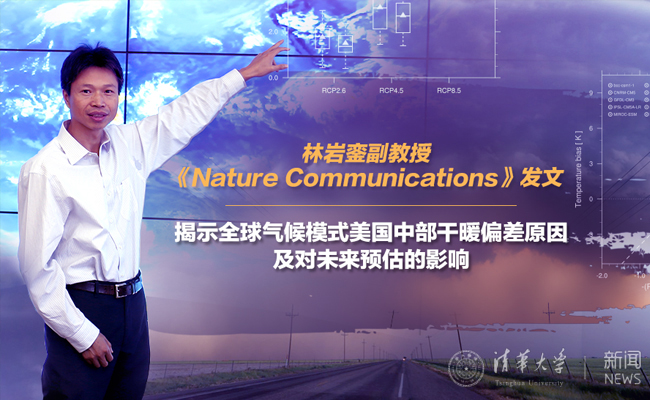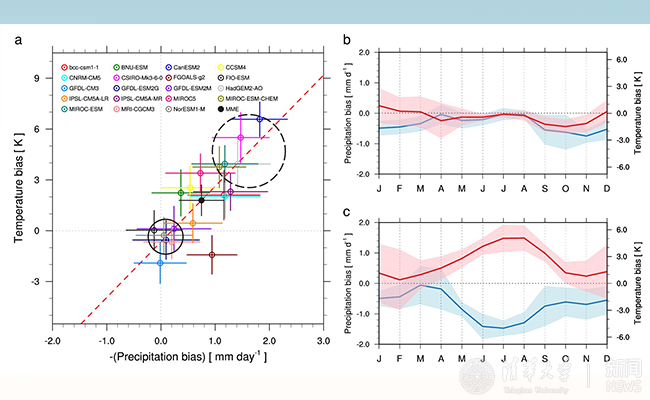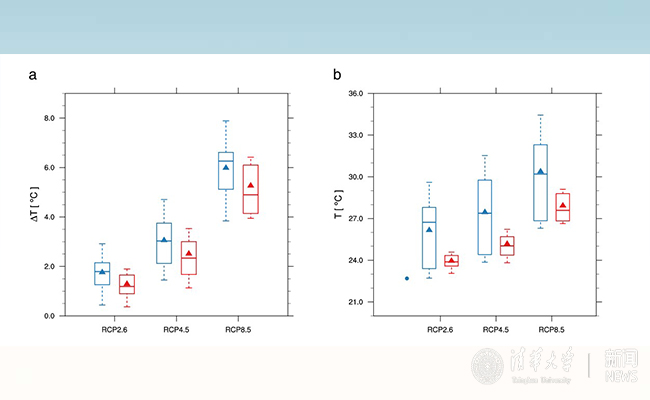Associate professor Yanluan Lin publishes paper revealing the causes of model dry and warm bias over central U.S. and its impact on future climate projections
On October 12th, Associate Professor Yanluan Lin from the Department of Earth System Science (hereinafter abbreviated as DESS) at Tsinghua University, as the first and corresponding author, published a paper entitled “Causes of model dry and warm bias over central U.S. and impact on climate projections” in Nature Communications. This study reveals the causes of the widespread warm and dry bias among 19 GCMs and investigated its impact on future climate projections.

Despite several decades of research to improve climate models, systematic biases of precipitation and temperature still persist on continental scales in the majority of climate models. These systematic biases pose significant uncertainties in the future projection of climate change in these regions. Among the model biases, one of the most conspicuous is the summertime warm and dry bias over the central U.S. that has persisted in many generations of regional and global climate models. For instance, the largest warm bias out of 19 GCMs reaches as high as 6.6K. Previous studies suggested that the land -atmosphere (soil moisture) feedback is crucial in causing the model deficiencies. Soil moisture deficit in this region can directly impact on the partitioning of diurnal radiative energy between latent and sensible heat fluxes through local evapotranspiration. Consequently, it influences the formation of shallow cumulus through planetary boundary layer interaction. Soil moisture deficit and the resultant underestimated shallow cumulus can lead to an excess of surface temperature and, meanwhile, reduce the formation of precipitation. Though these feedbacks have been extensively discussed, the origins of the biases are still unclear. Additionally, how the warm and dry bias impacts on future climate projection remains unclear and needs to be understood. Based on a massive observation data set, this study suggests that the cause of the identified warm/dry bias is likely triggered by the precipitation deficit arising from the model’s failure to capture large precipitation events, followed by strong and complex land–atmosphere interactions in different time scales. In addition, this study quantitatively analyzes the contribution of different feedbacks on the warm and dry bias, which would be beneficial to the development of the model.
The study further reveals a robust linear relationship between the projected warming and the present-day warm bias, which is used to empirically correct future temperature projections. By the end of the 21st century under the RCP8.5 scenario, the corrections substantially narrow the intermodel spread of the projections and reduce the projected temperature by 2.5K, resulting mainly from the removal of the warm bias. Instead of a sharp decrease, after this correction the projected precipitation is nearly neutral for all scenarios. Meanwhile, the correction leads to a much narrower spread of future changes among the models than one directly simulated by the models, which can have important implications for appropriate decision making.

a. Scatter plot of the summertime temperature bias and precipitation bias over the central U.S. from 19 CMIP5 historical simulations during the reference period 1979–2005.
b. Seasonal evolution of temperature and precipitation biases for the good group. The solid circle contains the models selected as good group.
c. Same as b but for the bad group. The dash circle contains the models selected as bad group.

a. Boxplot of temperature changes with (red)/without (blue) bias correction for the three scenarios.
b. As in a but for absolute temperature. Solid dots in the first columns represent the observations (averaged over 1980–1999).
Associate professor Yanluan Lin has published three articles in Nature Communications since 2015. His research group focuses on the understanding of different weather systems and their responses to climate change, and future projections using GCMs. The results would benefit the development of more effective strategies for climate change adaptation, water resource management, and environmental protection. PhD candidate Wenhao Dong, instructed by Associate Professor Yanluan Lin, is the joint first author of this article, and Professor Minghua Zhang from Stony Brook University is the joint corresponding author. Associate Professor Wei Xue from the Department of Computer Science and Technology and Professor Yong Luo from DESS also contributed to the paper.
Article link: http://www.nature.com/articles/s41467-017-01040-2
(Edited by Guo Lili, Zhu Lvhe)

